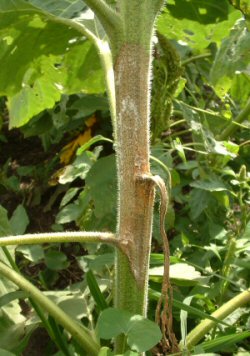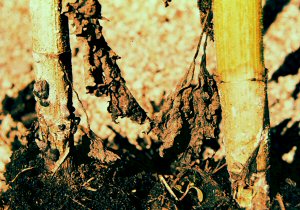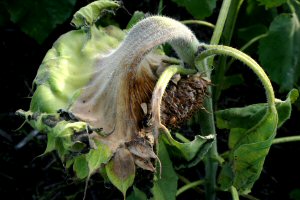Sclerotinia In Sunflowers
Sclerotinia wilt and head rot are generally the most important diseases affecting sunflowers.

Figure 1

Figure 2

Figure 3
Host Crops
Sunflowers, canola, mustard, dry beans, field peas, lentils, potatoes
Biology
Sclerotinia survives in the soil for up to four years as irregularly-shaped fungal bodies called sclerotia. The sclerotia germinate in the summer, producing either mycelia that infect sunflower roots causing wilt or mushroom-like structures (apothecia) that release wind-borne spores that infect the head causing head rot. When it comes to sunflowers getting infected through the roots (sclerotia germinating to produce mycelia), there is no requirement for wet soil. Wet soil is required for sclerotia to germinate to produce apothecia. Head rot infection is favoured by extended periods of rain, several weeks prior to and during flowering.
The symptoms of sclerotinia wilt usually appear during flowering.
Diseased plants may occur singly or in patches. The upper leaves droop, dry out, and die. The entire plant dies quickly. Young wilted plants often turn black whereas mature plants usually remain light brown. Small irregularly-shaped bodies can be found inside the stem near the soil line. Surviving plants may or may not produce seed, depending on when the infection occurs. The heads on wilted plants generally are smaller than those on healthy plants and seed weights are lower.
Head rot (Figure 3) is caused by wind-borne spores of the same fungus. It usually occurs late in the season, after initial flowering and extended periods of wet weather. Dead petals on the back of the heads provide a place for the spores to germinate. The affected heads decay, become soft, and black sclerotia form within the heads.
Head rot also causes a decrease in oil content and an increase in free fatty acid content. The sclerotia that form in diseased stalks and heads are returned to the soil at harvest and can cause sclerotinia diseases in sunflower or other susceptible crops in following years.
Symptoms Of Damage
In general, the symptoms of damage include drooping, brown or dead upper leaves; plants that turn brown or black and die prematurely (Figure 1); fungal bodies (sclerotia) in the stem at the soil line; (Figure 2) soft, rotting heads (Figure 3) with only fibrous tissue remaining; and black sclerotia in the heads. The characteristic symptoms of sclerotinia wilt include sudden wilting of leaves, root rot, and a basal stem canker. The first wilted plants are usually seen just before flowering but most appear in patches during and after flowering. The time required from incipient wilt to complete wilting may be four to seven days.
The first symptoms of head rot usually are the appearance of water-soaked spots or bleached areas on receptacles (the fleshy back of the head). The fungus can decay the entire receptacle and the seed layer falls away leaving only a bleached, shredded skeleton interspersed with large sclerotia.
Scouting Techniques
With sclerotinia wilt, young wilted plants often turn black. Mature plants usually remain light brown. Small, irregularly-shaped, sclerotia can be found inside the stem, near the soil line.
The bleached, skeletonized heads associated with head rot are very obvious in the field, even from a distance. Infected heads usually shatter during combining and any remaining seeds are lost. Usually, the seeds are not decayed but many are empty. The large sclerotia in the heads may be 12 millimeters (1/2 inch) or greater in diameter and many are harvested along with the seed. Large sclerotia mixed in with seed confirms that a field contained head rot.
Economic Thresholds
Fungicides are not currently effective in controlling sclerotinia rot. Wilt occurs whenever sunflower is planted on sclerotinia-infested soil and can cause severe yield loss. On the average, infected plants yield less than 50 per cent of healthy plants. Sclerotinia wilt also leads to increased levels of sclerotia in the soil which, in turn, can result in the removal of fields from sunflower production for many years.
Control Tips
- The key to managing these diseases is to plant in non-infested soil and prevent the buildup of sclerotia in soil.
- Monitor fields for sclerotinia diseases and rotate crops. Follow a crop rotation of 5 years between susceptible crops.
- To minimize head rot, plant to maximize air circulation. Locate new plantings as far away as possible from fields where sclerotinia was know to be a problem in the previous four years.
- Although no resistant hybrids are available, progress is being made in reducing the susceptibility of sunflowers to sclerotinia.
For further information, contact your GO representative.

